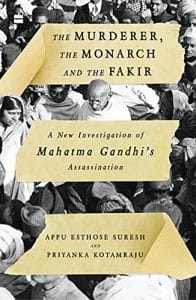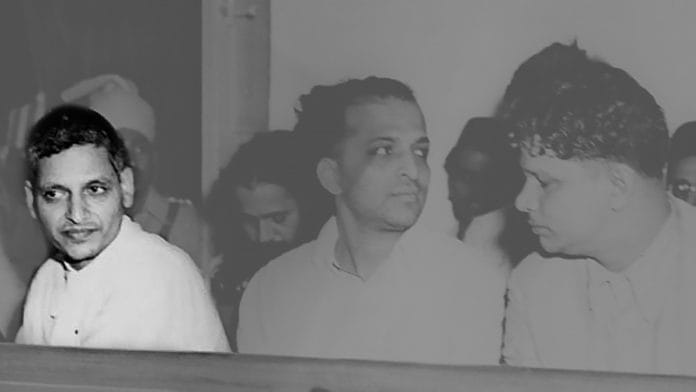4 February 1948
From this day on, events began to unfold fast and furious. The Indian government, still reeling from the shock of the Mahatma’s assassination, decided to ban the RSS and was planning to make a big arrest—that of the prolific right-wing militant Hindu leader, Vinayak Damodar Savarkar. Although the government was preparing to ban the RSS, there was no actual evidence at the time linking the organization to Gandhi’s assassination.
Out of the seven raids conducted by the Delhi Police in search of Gandhi’s assassin, only one of them was on an RSS leader. The 2 February raid was on then municipal commissioner and RSS chalak (branch head) Hari Chand, where the police only recovered postcards, articles, some propaganda literature and a few paper cuttings on the basis of a First Information Report (FIR) filed at the Faiz Bazar police station.6 Hauz Qazi Station House Officer Ram Dutt recovered eighteen documents from Hari Chand’s residence, none of them incriminated the RSS. But it was no secret that RSS had wished for Gandhi’s death. In many meetings, its members had discussed Gandhi at length.
The Mahatma was the single-biggest stumbling block for the RSS and other like-minded militant Hindu organizations and their anti-Muslim agenda. In fact, the Crime Investigation Division of the Delhi Police and Intelligence Bureau had many intelligence reports to this effect. Yet, on the day the RSS was banned, there wasn’t a shred of evidence linking the organization to the murder. The Indian government was mistaken, particularly Home Minister Sardar Patel, in assuming that the RSS was a volunteering arm of the Hindu Mahasabha. In its formative years, the camaraderie between the Sangh and the Hindu Mahasabha gave an impression that both organizations were closely related. However, by the 1940s, the connection between the Sangh and Mahasabha was tenuous. They may have been ideologically aligned, but organizationally, the two had grown far apart. It was a strange coincidence that the reason for their strained relationship was Vinayak Damodar Savarkar.
This was also the time when their approaches began to differ. Savarkar placed military training as top priority while Golwalkar wanted to abolish the military department of the RSS altogether. However, the lack of evidence didn’t stop the Indian government from arresting Golwalkar on 3 February 1948. On the other hand, DSP Singh had gathered a lot more direct evidence against Savarkar.
The 26 January interrogation report of Madanlal mentioned Savarkar. More than one needle of suspicion pointed towards Savarkar as the mastermind of the murder— partly because of his profile and also because of the low-key profiles of the co-consipirators. Far away from the chaos that had engulfed Delhi, Savarkar, ailing and retired from active politics, was in Bombay. Even in retirement, he was the tallest Hindutva leader.
Also read: Godse was ‘yearning’ for Savarkar’s support in Gandhi murder trial court. But it never came
The Green Taxi
DSP Singh interrogated Godse for the first time on the afternoon of 1 February 1948. The next day, the interrogation began at 10 a.m. and went on for nine hours until 7 p.m. On the third consecutive day, questioning began at around 1 p.m. So far, Godse had not cracked. He stuck to the story that he had masterminded the assassination, only conceding that he arrived in Delhi with Narayan Apte. The DSP had not managed to get any evidence confirming Savarkar’s role. Frustrated, the cop noted, ‘I continued interrogating Godse accused at Parliamentary Street police station, but nothing useful was revealed.’
Time was moving. The pressure was building on DSP Singh to unravel the conspiracy. On 4 February at 5 p.m., the cop asked Head Constable Parasram to get a taxi for him. India, a young nation, was in dire need of resources; there weren’t enough police vehicles to deploy, even for the country’s most important investigation. It was at this time that destiny intervened once again. The first taxi Parasram hailed was out of order. A second one came along, owned by Surjit Singh, a Jat driver from DSP Singh’s native Jalandhar in Punjab. The cop recognized the taxi by its colour and number plate, ‘PBF 671’; it was only two days ago that he had asked Assistant Sub-Inspector Shiv Prasad to trace this particular vehicle.
One of the few details Godse had coughed up during interrogation was that he, Apte, Gopal and Karkare had left Birla House on 20 January in a green car chauffeured by a young Sikh driver, Surjit Singh. Twenty-four-year-old Singh was the owner of a Chevrolet car, which was registered in Lahore. He had arrived in Delhi just six months ago and had been privately plying his car as a taxi. This was a second-hand car with very distinctive features that made it immediately noticeable in Delhi. For one, the colour of his car was green, the same as moong dal. His was perhaps the only car in the city at the time to have a luggage carrier; witnesses later identified this as the ‘moongiya’ car with the ‘jungla’ (luggage carrier) on top.
In a stroke of extraordinary luck, Parasram had hailed the same taxi that Godse and the others used as a getaway vehicle after the first assassination attempt.
Also read: Gwalior to Godse — Was Sardar Patel soft on Savarkar in Gandhi murder case, and if so, why
Rewind
On 20 January, Surjit Singh’s green taxi had picked up four passengers from the Regal Cinema taxi stand. Their destination was Birla House, via Birla Mandir, located on Albuquerque Road (now Tees January Marg). His four passengers were Narayan Apte, Digambar Badge, Shankar Kistayya and Gopal Godse. This hardly raised any suspicion; after all, people often came to attend Gandhi’s evening prayer meetings. The car was parked at the back of Birla House.
The four passengers entered and made their way to the servant quarters. Surjit Singh himself entered the prayer ground and waited for about fifteen minutes. Prayers had not yet begun and the loudspeaker seemed to be out of order. Forty-five minutes after disembarking, the passengers returned. However, Badge did not return. Nathuram Godse came instead. As they sat in the car, an explosion went off inside Birla House. The passengers asked Surjit Singh to ‘start the car’ twice. The cabbie’s account showed that the four members of Gandhi’s murder squad left the scene of crime before Madanlal ignited the guncotton.
Badge and his servant were still at the prayer meeting, while Madanlal was apprehended by an enraged crowd after a witness, Sulochana Devi, pointed him out to the constables guarding the house. Sulochana Devi was in her early twenties. She lived about 200 to 300 steps from the Birla House at 9, Albuquerque Road. In her account, she said she was following her three-year-old child who had run out of the house towards Birla House from the back. She had seen a ‘moongiya coloured’ car parked there. Nearly fifteen paces from her, she saw Madanlal placing a bomb and lighting a matchstick to ignite it. Then the explosion happened.
Also read: Don’t hang Godse, said Gandhi’s sons. This is how Nehru, Patel and Rajaji replied
Surjit Singh dropped off the murder squad at Tata Airways in Connaught Place. Just a few hours earlier, the group had united for one last time at Room Number 40 of Marina Hotel, also in Connaught Place, where they stayed until 4 p.m. that day. This was the same hotel Apte and Godse had checked into a few days earlier, on 17 January, under the false names of S. Deshpande and M. Deshpande. Gobindram, a twenty-year-old bearer at the Marina Hotel, even reported that the people in Room Number 40 ordered one peg of whiskey the first day and two pegs the next day. All drinks were consumed by Karkare, the sethji.
At 4 p.m. on 20 January, Godse left for Birla House on a tonga owned by Munshi Ram, whereas four others took Surjit Singh’s green taxi. On that morning, the squad met at the Hindu Mahasabha Bhawan. The jungle behind the building served as a shooting range for Gopal Godse to practise firing with his revolver. Madanlal borrowed a screwdriver and some oil from the Hindu Mahasabha Bhawan to tinker with the revolver. Nathuram Godse was not present as he was unwell. Madanlal and Karkare took a tonga back to the hotel for the final meeting. The squad went over the plan.
 This excerpt from ‘The Murderer, the Monarch and the Fakir: A New Investigation of Mahatma Gandhi’s Assassination’ has been published with permission from HarperCollins India.
This excerpt from ‘The Murderer, the Monarch and the Fakir: A New Investigation of Mahatma Gandhi’s Assassination’ has been published with permission from HarperCollins India.






